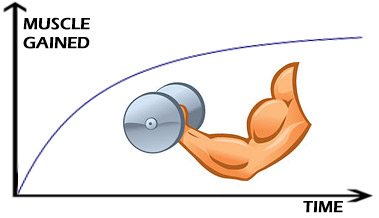BUILDING MUSCLE NATURALLY: THE LAW OF DIMINISHING RETURNS

Despite how it’s usually portrayed in advertisements for over-hyped supplements and bodybuilding “miracle programs”, the fact is simple…
Building muscle naturally is a relatively slow and gradual process for the average lifter.
Dramatic body transformations don’t happen over night, and it requires time, patience and consistent effort over the long term to truly pack on a significant amount of lean mass.
Assuming you’re following a proper training and nutrition plan and are sticking to it closely, a standard rate of natural muscle growth for a beginning lifter would probably be somewhere around half a pound per week during the first year of lifting.
Factor in the additional increases in water weight, muscle glycogen and the inevitable extra body fat that comes with a focused bulking phase, and you’re probably looking at about 2-3 pounds of total weight gain per month on average.
Another very important principle that natural lifters need to be aware of and understand is the “law of diminishing returns” that you’ll experience as you progress from one year of training to the next.
In other words, it’s the simple fact that the longer you’ve been in the gym and the more total muscle you’ve gained, the more your rate of growth will naturally slow down and the longer it will take to make additional progress.
Building Muscle Naturally Is NOT A Linear Process

Just because you happened to gain, say, 15 pounds of muscle during one year of training does not automatically mean you’re going to gain another 15 pounds the following year and another 15 the year after that.
Muscle growth is not a consistent linear process from one phase of lifting to the next, and instead operates more like a curve as seen above.
When you first start out in the gym you’ll make your “newbie gains” relatively quickly since weight training will be a brand new stimulus for your body and you won’t be carrying a lot of muscle to begin with.
After that initial 6-12 month period is over and your body is holding onto a larger amount of muscle and has become more accustomed to training, the process will naturally decelerate.
Remember, your body doesn’t actually want to hold onto all of this excess muscle you’re trying to build.
Muscle requires a large amount of energy and resources to build and maintain, and your body has genetic limits in place to prevent you from gaining too much.
So, as you get further and further away from your natural “set point”, the harder and harder your body will start slamming on the brakes to ensure that its levels of lean muscle mass don’t climb to an excessive amount.
Why Realistic Muscle Building Expectations Are Important

This isn’t meant to be a “downer” or intended to discourage your bodybuilding efforts in any way; it’s a concept that is actually crucial to understand in order to keep yourself motivated and on track toward your ultimate goals.
This is because if you’re expecting to build muscle at a perfectly linear rate but aren’t seeing the gains you expected, you may become liable to start pushing the envelope with your training and nutrition in a way that can have real negative consequences.
First off, it could potentially lead to injury if you get carried away in the gym in terms of overall workout volume, frequency and intensity out of frustration at what you perceive to be unsatisfactory results.
Second, it could cause your progress to stagnate altogether if you begin unnecessarily “program hopping” from one plan to the next because you were expecting faster gains and are constantly under the impression that something is wrong with your current routine.
Thirdly, and most commonly, it could cause you to put on an excessive amount of body fat if you go overboard on total food intake in an attempt to replicate your rate of muscle gain from previous periods of training.
You’ll watch the scale steadily climb and think you’re packing on pound after pound of pure muscle, when in reality a very high percentage of it will simply be fat.
This is something that happened to me personally as an intermediate lifter when I didn’t truly understand how building muscle naturally really worked.
I hugely over-estimated how much muscle my body was capable of gaining within a certain time frame and was literally stuffing myself with food all day long trying to duplicate my gains from the previous two years of lifting.
I ended up packing on a very large amount of extra body fat as a result, and when I finally did decide to cut later on, I very quickly realized that the amount of actual lean muscle I had built was far less than I thought.
Realistic Natural Muscle Growth Rate: What Should You Expect?

I covered this in a post a few weeks back (“How Much Muscle Can You Gain Naturally?“), but assuming you’re implementing a properly structured program on a consistent basis, you’ll likely reach around 50% of your noticeable genetic muscle building potential within the first year of lifting. (Assuming you’re fully grown and are starting from a normal healthy body weight)
From there, it will decrease by about half for every year that follows.
In other words, out of 100% of your ultimate genetic potential, this is what you might expect to achieve when building muscle naturally from year to year…
Year 1: 50% of genetic potential
Year 2: 75% of genetic potential
Year 3: 85-90% of genetic potential
At 4-5 years and beyond you’d be right up near your natural muscle building limit.
For guys with average genetics this would probably mean somewhere around 30 pounds of total lean muscle mass gained, and those with slightly below average or slightly above average genetics might be looking at around 20 or 40 pounds respectively.
There will also be a very small percentage of “genetic outliers” on the more extreme ends of the spectrum, including those who may only be able to build 10 pounds of total muscle no matter what they do, as well as those who can gain upward of 50 pounds of muscle or more.
Women can take these figures and decrease them by about half.
It’s not that you can’t build more muscle after 4-5 years of training as a natural lifter, but the rate of growth will have slowed down very sharply to where it may require several years of training just to gain a few additional pounds of muscle.
The Take Away Message On Building Muscle As A Natural Lifter

Always keep in mind that natural muscle growth is a game of diminishing returns, as this will give you realistic expectations about how the process works so that you remain patient and efficient with your training and nutrition approach.
Otherwise, you could easily end up injured, fat, or fat and injured which would of course be quite the opposite of what you’re after.
Some people may think of this as being a “pessimistic” message, but it’s simply a concrete fact of how building muscle naturally works.
Virtually anyone out there can pack on a significant amount of lean mass and carve out a highly impressive physique given enough time, but there are genetic limits in place that determine how fast you can gain muscle as well as how much total muscle you can ultimately put on.
By all means set big goals and aim to maximize your personal muscle building potential if that’s your goal, but don’t forget to maintain a realistic outlook by understanding that the further you progress, the harder additional progress will become.
For each new year of lifting that you embark on, you should expect to build muscle roughly half as quickly as the previous one.
Being aware of this isn’t just a matter of avoiding disappointment, but it will also prevent you from doing things in the gym or kitchen that are directly counterproductive to your physique.
Once you’re past the 4-5 year mark as a natural lifter (assuming you’ve done everything properly with your training and nutrition and have been consistent), it’s best to really allow your patience to kick in and to start thinking in terms of a much slower, gradual approach for continued progress over the long term.
If you found this article helpful, make sure to sign up for your FREE custom fitness plan below...

If you found this article helpful, make sure to sign up for your FREE custom fitness plan below...



